15 may 2015 Nakba
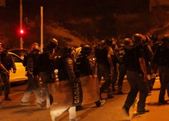
As thousands of Palestinians marked, on Friday, the 67th anniversary of the Palestinian Nakba, Israeli soldiers resorted to the excessive use of force against the protesters, causing dozens of injuries.
The Palestinians held protesters, starting on Friday afternoon, in different parts of the occupied city, and the West Bank.
The protesters affirmed national Palestinian unity, and ongoing struggle against the Israeli occupation of Palestine.
Hundreds of protesters marched in various alleys and streets in the Old City of occupied Jerusalem, challenging the soldiers who were extensively deployed in an attempt to stop the procession.
Clashes took place with the soldiers in Ras al-‘Amoud area, one of the most prominent gates of the Old City, after the soldiers used excessive forces against the protestors.
In addition, hundreds marched in Jabal al-Mokabber neighborhood, southeast of occupied Jerusalem marking the Nakba of 1948, and chanted against the ongoing Israeli occupation and aggression, including Israel’s illegal policies of home demolitions. Several mild injuries were reported.
Hundreds also marked the Nakba in Ras al-‘Amoud area, in Silwan town, south of the al-Aqsa Mosque, and commemorated the death of a local child, Milad ‘Ayyash, who was killed by army fire in 2011.
The Follow-Up Committee in the al-‘Eesawiyya town, south of the Al-Asa Mosque, said the soldiers fired dozens of gas bombs, firebombs, and rubber-coated metal bullets on Palestinian protestors.
The Committee added that 15 Palestinians were shot by rubber-coated metal bullets, while dozens suffered the effects of tear gas inhalation. Local youths used fireworks to target military jeeps, and hurled stones and empty bottles.
Clashes also too place near the main entrance of the Shu’fat refugee camp, in the center of Jerusalem.
The Israeli Police issued a statement revealing the three Border Guard officers have been injured, in the Suwwana neighborhood, on Friday at night.
In addition, at least ten Palestinians were injured in clashes that took place with the soldiers on the northern entrance of the ar-Ram town, north of occupied Jerusalem, and were moved to local medical centers.
Similar clashes took place in Bir Nibala town, west of Jerusalem.
In addition, soldiers invaded the main entrance area of the Qalandia refugee camp, north of Jerusalem, kidnapped several Palestinians, and installed a roadblock on the Jaba’-Qalandia road, northeast of Jerusalem.
The Palestinians held protesters, starting on Friday afternoon, in different parts of the occupied city, and the West Bank.
The protesters affirmed national Palestinian unity, and ongoing struggle against the Israeli occupation of Palestine.
Hundreds of protesters marched in various alleys and streets in the Old City of occupied Jerusalem, challenging the soldiers who were extensively deployed in an attempt to stop the procession.
Clashes took place with the soldiers in Ras al-‘Amoud area, one of the most prominent gates of the Old City, after the soldiers used excessive forces against the protestors.
In addition, hundreds marched in Jabal al-Mokabber neighborhood, southeast of occupied Jerusalem marking the Nakba of 1948, and chanted against the ongoing Israeli occupation and aggression, including Israel’s illegal policies of home demolitions. Several mild injuries were reported.
Hundreds also marked the Nakba in Ras al-‘Amoud area, in Silwan town, south of the al-Aqsa Mosque, and commemorated the death of a local child, Milad ‘Ayyash, who was killed by army fire in 2011.
The Follow-Up Committee in the al-‘Eesawiyya town, south of the Al-Asa Mosque, said the soldiers fired dozens of gas bombs, firebombs, and rubber-coated metal bullets on Palestinian protestors.
The Committee added that 15 Palestinians were shot by rubber-coated metal bullets, while dozens suffered the effects of tear gas inhalation. Local youths used fireworks to target military jeeps, and hurled stones and empty bottles.
Clashes also too place near the main entrance of the Shu’fat refugee camp, in the center of Jerusalem.
The Israeli Police issued a statement revealing the three Border Guard officers have been injured, in the Suwwana neighborhood, on Friday at night.
In addition, at least ten Palestinians were injured in clashes that took place with the soldiers on the northern entrance of the ar-Ram town, north of occupied Jerusalem, and were moved to local medical centers.
Similar clashes took place in Bir Nibala town, west of Jerusalem.
In addition, soldiers invaded the main entrance area of the Qalandia refugee camp, north of Jerusalem, kidnapped several Palestinians, and installed a roadblock on the Jaba’-Qalandia road, northeast of Jerusalem.

Still Image From Palestine TV Report
Israeli soldiers invaded, on Friday afternoon, Silwad and Betunia towns, near the central West Bank city of Ramallah, and attacked dozens of Palestinians marking the Nakba Day.
The Palestine TV has reported that several military vehicles invaded the southern area of Silwad town, and clashed with dozens of local youths.
The soldiers fired dozens of gas bombs, concussion grenades, rubber-coated metal bullets, and several rounds of live ammunition.
Medical sources said ten Palestinians suffered the effects of tear gas inhalation, and received treatment by local medics.
During the clashes, a number of youths hurled Molotov cocktails on the invading soldiers, while the army also fired the “Tutu” live ammunition on the protestors.
The Tutu live rounds cause larger bodily harm, and were outlawed by an Israeli court in 2001, but the army continued to use them.
Israeli sources said a number of soldiers were mildly injured during the clashes with local youths in the town, while a few soldiers received treatment for the effects of tear gas inhalation, after the protestors managed to throw back some of the gas bombs fired at them.
In addition, clashes took place in Betunia nearby town, after the soldiers invaded it, and attacked local protesters marking the Nakba, and marking the first anniversary of the death of Nadim Nuwwara and Mohammad Abu Thaher, who were killed by Israeli army fire, on May 15 2014.
The soldiers fired dozens of gas bombs, in addition to rubber-coated metal bullets and live rounds, while local youths hurled stones and empty bottles on the soldiers; several Palestinians suffered the effects of tear gas inhalation.
Local protesters also burnt Israeli flags, and said, “The Palestinians will never abandon their legitimate rights of liberation and independence in their homeland.”
Israeli soldiers invaded, on Friday afternoon, Silwad and Betunia towns, near the central West Bank city of Ramallah, and attacked dozens of Palestinians marking the Nakba Day.
The Palestine TV has reported that several military vehicles invaded the southern area of Silwad town, and clashed with dozens of local youths.
The soldiers fired dozens of gas bombs, concussion grenades, rubber-coated metal bullets, and several rounds of live ammunition.
Medical sources said ten Palestinians suffered the effects of tear gas inhalation, and received treatment by local medics.
During the clashes, a number of youths hurled Molotov cocktails on the invading soldiers, while the army also fired the “Tutu” live ammunition on the protestors.
The Tutu live rounds cause larger bodily harm, and were outlawed by an Israeli court in 2001, but the army continued to use them.
Israeli sources said a number of soldiers were mildly injured during the clashes with local youths in the town, while a few soldiers received treatment for the effects of tear gas inhalation, after the protestors managed to throw back some of the gas bombs fired at them.
In addition, clashes took place in Betunia nearby town, after the soldiers invaded it, and attacked local protesters marking the Nakba, and marking the first anniversary of the death of Nadim Nuwwara and Mohammad Abu Thaher, who were killed by Israeli army fire, on May 15 2014.
The soldiers fired dozens of gas bombs, in addition to rubber-coated metal bullets and live rounds, while local youths hurled stones and empty bottles on the soldiers; several Palestinians suffered the effects of tear gas inhalation.
Local protesters also burnt Israeli flags, and said, “The Palestinians will never abandon their legitimate rights of liberation and independence in their homeland.”
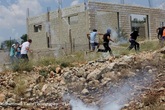
The Popular Committee against the Wall and Settlements in Bil’in village, near the central West Bank city of Ramallah, has reported that Israeli soldiers have attacked the weekly protest, firing dozens of gas bombs and rubber-coated metal bullets.
This week’s protest marks May 15, the Palestinian Nakba Day when Israel was established in the historic land of Palestine after massive expulsion of the indigenous population and the destruction of hundreds of villages and towns.
The Popular Committee said that locals, accompanied by Israeli and International peace activists, marched from the center of the village towards Palestinian orchards, isolated by the Wall and illegal Israeli colonies.
The protesters marched nonviolently, carrying Palestinian flags, and black flags commemorating the Nakba, chanted and sang for Palestinian unity, liberation, independence, and the Right of Return of all refugees.
They also chanted for th ongoing popular resistance against the Israeli occupation and its illegal colonies, and for the release of all political prisoners.
The soldiers intercepted the protest firing dozens of gas bombs and rubber-coated metal bullets, and invaded and western area of Bil’in.
They also chased the protesters through olive orchards, and in between homes in the village while firing more gas bombs, also targeting local homes with them.
Medical sources said that dozens of residents, Israeli and international peace activists, suffered the effects of tear gas inhalation.
The gas bombs also set fire to a number of olive trees belonging to the villagers, while residents rushed to contain the fire.
This week’s protest marks May 15, the Palestinian Nakba Day when Israel was established in the historic land of Palestine after massive expulsion of the indigenous population and the destruction of hundreds of villages and towns.
The Popular Committee said that locals, accompanied by Israeli and International peace activists, marched from the center of the village towards Palestinian orchards, isolated by the Wall and illegal Israeli colonies.
The protesters marched nonviolently, carrying Palestinian flags, and black flags commemorating the Nakba, chanted and sang for Palestinian unity, liberation, independence, and the Right of Return of all refugees.
They also chanted for th ongoing popular resistance against the Israeli occupation and its illegal colonies, and for the release of all political prisoners.
The soldiers intercepted the protest firing dozens of gas bombs and rubber-coated metal bullets, and invaded and western area of Bil’in.
They also chased the protesters through olive orchards, and in between homes in the village while firing more gas bombs, also targeting local homes with them.
Medical sources said that dozens of residents, Israeli and international peace activists, suffered the effects of tear gas inhalation.
The gas bombs also set fire to a number of olive trees belonging to the villagers, while residents rushed to contain the fire.
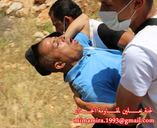
More than 1,200 Palestinians, accompanied by Israeli and international peace activists, marched in the weekly protest in Ni’lin village on Friday, near the central West Bank city of Ramallah, marking the 67th anniversary of the Palestinian Nakba (May 15 1948). Five Palestinians were shot, and dozens more suffered the effects of tear gas inhalation.
The Popular Committee against the Wall and Settlements in Ni’lin has reported that the protesters, including representatives of Palestine Liberation Organization (PLO), various other political factions, as well as representatives of National Committee of Commemorating the Nakba, the Global Campaign to Return to Palestine, the Right to Land Coalition, the Coordination Committee against the Wall, marched along with Israeli and international activist, starting at noon in the center of the village.
The Nakba Commemoration started in the village with a speech by the head of the Ni’lin Village Council, Nader al-Khawaja, who welcomed both Palestinians and activists, including those who came from different cities, towns and refugee camps across the occupied West Bank, and especially the villagers living close to illegal Israeli settlements.
Al-Khawaja saluted the residents of Ni’lin and their determination to continue their legitimate struggle against the apartheid wall and colonies which isolate them from their orchards.
He added that Ni’lin has been holding the ongoing protest against the wall and settlements for eight consecutive years, now, embracing their steadfastness and determination to defend their lands despite the ongoing Israeli violations and excessive use of force by the soldiers.
It is worth mentioning that the soldiers detained Palestinians coming from Hebron, Bethlehem and Salfit to participate in this week’s protest marking the Palestinian Nakba of 1948.
The Imam of Ni’lin said in a speech, following noon prayers in the center of the village, that Ni’lin and its ongoing nonviolent popular resistance, has become a symbol of the national struggle against the occupation, and a symbol for national unity.
He added that the Nakba of 1948 did not just happen and end, as it is ongoing, while refugees continue to suffer, and Palestinians continue to be targeted by Israel's illegal occupation and colonial settlements.
The imam called for national unity among all factions, among the Palestinian people, so that the struggle can continue until liberation and independence, and until achieving the Right of Return of all refugees.
The procession then took off from the southern area of the village heading towards the Annexation Wall and the settlements that were illegally built on Palestinian lands, while the residents chanted in demand of their legitimate Palestinian rights.
Israeli soldiers used excessive force against the protesters, firing rubber-coated metal bullets and dozens of gas bombs, wounding five Palestinians, while dozens suffered the effects of tear gas inhalation. The gas bombs also set fired to olive orchards and farmlands, the only source of livelihood for literally hundreds of villages.
The Popular Committee against the Wall in Ni’lin said that the soldiers installed roadblocks oat the entrances of the village over the past week, in an attempt to isolate it and prevent residents from reaching it to participate in the protest, and even installed surveillance cameras on the main road and main entrance of the village.
It added that dozens of soldiers were also deployed near the second roadblock, installed by the army near Palestinian orchards belonging to villages of Ni’lin and several nearby villages.
The Popular Committee against the Wall and Settlements in Ni’lin has reported that the protesters, including representatives of Palestine Liberation Organization (PLO), various other political factions, as well as representatives of National Committee of Commemorating the Nakba, the Global Campaign to Return to Palestine, the Right to Land Coalition, the Coordination Committee against the Wall, marched along with Israeli and international activist, starting at noon in the center of the village.
The Nakba Commemoration started in the village with a speech by the head of the Ni’lin Village Council, Nader al-Khawaja, who welcomed both Palestinians and activists, including those who came from different cities, towns and refugee camps across the occupied West Bank, and especially the villagers living close to illegal Israeli settlements.
Al-Khawaja saluted the residents of Ni’lin and their determination to continue their legitimate struggle against the apartheid wall and colonies which isolate them from their orchards.
He added that Ni’lin has been holding the ongoing protest against the wall and settlements for eight consecutive years, now, embracing their steadfastness and determination to defend their lands despite the ongoing Israeli violations and excessive use of force by the soldiers.
It is worth mentioning that the soldiers detained Palestinians coming from Hebron, Bethlehem and Salfit to participate in this week’s protest marking the Palestinian Nakba of 1948.
The Imam of Ni’lin said in a speech, following noon prayers in the center of the village, that Ni’lin and its ongoing nonviolent popular resistance, has become a symbol of the national struggle against the occupation, and a symbol for national unity.
He added that the Nakba of 1948 did not just happen and end, as it is ongoing, while refugees continue to suffer, and Palestinians continue to be targeted by Israel's illegal occupation and colonial settlements.
The imam called for national unity among all factions, among the Palestinian people, so that the struggle can continue until liberation and independence, and until achieving the Right of Return of all refugees.
The procession then took off from the southern area of the village heading towards the Annexation Wall and the settlements that were illegally built on Palestinian lands, while the residents chanted in demand of their legitimate Palestinian rights.
Israeli soldiers used excessive force against the protesters, firing rubber-coated metal bullets and dozens of gas bombs, wounding five Palestinians, while dozens suffered the effects of tear gas inhalation. The gas bombs also set fired to olive orchards and farmlands, the only source of livelihood for literally hundreds of villages.
The Popular Committee against the Wall in Ni’lin said that the soldiers installed roadblocks oat the entrances of the village over the past week, in an attempt to isolate it and prevent residents from reaching it to participate in the protest, and even installed surveillance cameras on the main road and main entrance of the village.
It added that dozens of soldiers were also deployed near the second roadblock, installed by the army near Palestinian orchards belonging to villages of Ni’lin and several nearby villages.
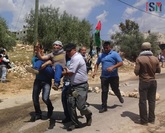
Protestor shot in his leg with live ammunition.
Today (15th of May), during the Nakba day demonstration in Kafr Qaddum, four young men were shot with live ammunition in their legs. One of the men got a serious bone fracture.
Apart from the live ammunition being shot from all directions, Israeli forces fired several rounds of rubber coated steel bullets, tear gas and stun grenades. Throughout the protest, the Israeli military forces used a skunk truck to force the demonstrators back from reaching the closed road; closed since 2002 due to the building of the settlement Kedumim. ISMers in the demonstration saw houses and gardens being sprayed, and a boy as young as four crying, covered in the noxious chemical skunk ‘water’.
Before the prayer had started, which end usually marks the beginning of the demonstration, soldiers attacked the gathered crowd with the chemical-laced water from the skunk truck. About 200 protesters marched up towards the closed road and were chanting words of freedom. 67 years later, the Nakba is still going on. They were soon met with rubber coated steel bullets and more skunk water.
The Israeli military fired tear gas and several protesters suffered from its inhalation and its blinding effect. The military then fired sound bombs and also started firing live .22 calibre ammunition. Anas, 25 years old, was hit with one of these live bullets in his leg, fracturing it. Within a few minutes, Odaye, 21 years old, had both legs pierced from the side with one of them too – the bullet first went through one leg and then into the other. Joseph, 23 years old, was hit by two bullets in the leg.
He was brought in to the hospital with a regular car as both of the ambulances had already left with casualties. Bilal, 22 years old, was also hit by a .22 bullet in his leg. He was also ferried to hospital in a private car. When the soldiers retreated, the youth continued the protest with burning tires – the smoke from the demo drifted up towards the illegal settlement of Kedumim.
The villagers of Kafr Qaddum demonstrate weekly against the closure of the road between their village and Nablus, since 2002. The Palestinians are not allowed to travel the most direct route to Nablus, 13 km away, due to the positioning of nearby illegal Israeli settlement Kedumim. The commute to Nablus from Kafr Qaddum has now doubled.
Today’s demonstration at Kafr Qaddum was just one of many large scale demonstrations held in commemoration of Nakba Day. The Nakba is the Palestinian name for the ethnic cleansing of the vast majority of Palestinian Arabs from Historic Palestine in 1948. The systematic massacres and expulsion of some 700,000 Palestinians and the destruction of 500 villages by Zionist paramilitary groups paved the way for the creation of Israel as an ethnically and ideologically ‘Jewish State’.
The ethnic cleansing of the Palestinians by Israeli zionists did not stop in 1948. Both within the recognised boundaries of the Israeli state and within the illegally Occupied Palestinian Territories, Palestinians are struggling daily against expulsion and land theft. In Kafr Qaddum, as in the rest of Palestine, Israel’s attempts at ethnic cleansing are being resisted.
Additional photos
Today (15th of May), during the Nakba day demonstration in Kafr Qaddum, four young men were shot with live ammunition in their legs. One of the men got a serious bone fracture.
Apart from the live ammunition being shot from all directions, Israeli forces fired several rounds of rubber coated steel bullets, tear gas and stun grenades. Throughout the protest, the Israeli military forces used a skunk truck to force the demonstrators back from reaching the closed road; closed since 2002 due to the building of the settlement Kedumim. ISMers in the demonstration saw houses and gardens being sprayed, and a boy as young as four crying, covered in the noxious chemical skunk ‘water’.
Before the prayer had started, which end usually marks the beginning of the demonstration, soldiers attacked the gathered crowd with the chemical-laced water from the skunk truck. About 200 protesters marched up towards the closed road and were chanting words of freedom. 67 years later, the Nakba is still going on. They were soon met with rubber coated steel bullets and more skunk water.
The Israeli military fired tear gas and several protesters suffered from its inhalation and its blinding effect. The military then fired sound bombs and also started firing live .22 calibre ammunition. Anas, 25 years old, was hit with one of these live bullets in his leg, fracturing it. Within a few minutes, Odaye, 21 years old, had both legs pierced from the side with one of them too – the bullet first went through one leg and then into the other. Joseph, 23 years old, was hit by two bullets in the leg.
He was brought in to the hospital with a regular car as both of the ambulances had already left with casualties. Bilal, 22 years old, was also hit by a .22 bullet in his leg. He was also ferried to hospital in a private car. When the soldiers retreated, the youth continued the protest with burning tires – the smoke from the demo drifted up towards the illegal settlement of Kedumim.
The villagers of Kafr Qaddum demonstrate weekly against the closure of the road between their village and Nablus, since 2002. The Palestinians are not allowed to travel the most direct route to Nablus, 13 km away, due to the positioning of nearby illegal Israeli settlement Kedumim. The commute to Nablus from Kafr Qaddum has now doubled.
Today’s demonstration at Kafr Qaddum was just one of many large scale demonstrations held in commemoration of Nakba Day. The Nakba is the Palestinian name for the ethnic cleansing of the vast majority of Palestinian Arabs from Historic Palestine in 1948. The systematic massacres and expulsion of some 700,000 Palestinians and the destruction of 500 villages by Zionist paramilitary groups paved the way for the creation of Israel as an ethnically and ideologically ‘Jewish State’.
The ethnic cleansing of the Palestinians by Israeli zionists did not stop in 1948. Both within the recognised boundaries of the Israeli state and within the illegally Occupied Palestinian Territories, Palestinians are struggling daily against expulsion and land theft. In Kafr Qaddum, as in the rest of Palestine, Israel’s attempts at ethnic cleansing are being resisted.
Additional photos
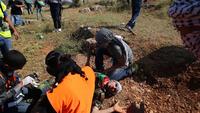
Demonstrators rush to the aid of a comrade injured during clashes with Israeli security forces following a demonstration to mark the 67th anniversary of the "Nakba" near the Israeli Ofer prison, in the West Bank village of Betunia near Ramallah on May 15, 2015.
Dozens of people have been injured after Tel Aviv regime’s forces fired live rounds to disperse thousands of Palestinian demonstrators marking the 67th anniversary of the Nakba Day (Day of the Catastrophe).
On Friday, thousands of Palestinians held massive rallies in Ramallah, Nablus, and al-Khalil (Hebron) in the occupied West Bank, to express their resentment over the ongoing Israeli occupation.
The angry protesters chanted slogans against the Tel Aviv regime’s expansionist agenda and the confiscation of Palestinian land by Israel.
Local residents and witnesses said that the demonstrations were largely peaceful until Israeli forces assaulted the protesters, fired teargas canisters, and live bullets to break up the protests. The protesters pelted stones at Israeli forces in return.
Palestinian medical and security sources said that nearly three dozen people were injured in the fierce clashes.
A series of scuffles and fierce clashes also broke out at a demonstration outside Ofer military prison near the West Bank administrative center of Ramallah.
Similar rallies were also held in several other towns and regions across the occupied territories.
Thousands of Palestinians also marched through al-Quds (Jerusalem) to mark al-Nakba. A large number of demonstrators waved Palestinian flags and marched toward the holy al-Aqsa mosque compound.
Palestinians in the besieged Gaza Strip also took to the streets to voice their anger against the Israeli occupation of their land. Israeli forces also shot and injured several Nakba Day protesters near the blockaded enclave.
Thousands of protesters attended a massive rally in Gaza City. At the rally, a speaker from the Palestinian Hamas resistance movement called for "continuing the resistance against the enemy Israel, until we liberate Palestine.”
Similar demonstrations were also held in some neighboring regional countries and other parts of the world.
Every year on May 15, Palestinians all over the world hold demonstrations to commemorate Nakba Day, which marks the anniversary of the forcible eviction of hundreds of thousands of Palestinians from their homeland by Israelis and the creation of the Israeli regime in 1948.
On May 15, 1948, Israeli forces displaced some 700,000 Palestinians, forcing them to flee to different neighboring countries. Israeli soldiers also wiped nearly 500 Palestinian villages and towns off the map, leaving an estimated total of 4.7 million Palestinian refugees and their descendants dreaming of an eventual return to their ancestral homeland more than six decades later.
Dozens of people have been injured after Tel Aviv regime’s forces fired live rounds to disperse thousands of Palestinian demonstrators marking the 67th anniversary of the Nakba Day (Day of the Catastrophe).
On Friday, thousands of Palestinians held massive rallies in Ramallah, Nablus, and al-Khalil (Hebron) in the occupied West Bank, to express their resentment over the ongoing Israeli occupation.
The angry protesters chanted slogans against the Tel Aviv regime’s expansionist agenda and the confiscation of Palestinian land by Israel.
Local residents and witnesses said that the demonstrations were largely peaceful until Israeli forces assaulted the protesters, fired teargas canisters, and live bullets to break up the protests. The protesters pelted stones at Israeli forces in return.
Palestinian medical and security sources said that nearly three dozen people were injured in the fierce clashes.
A series of scuffles and fierce clashes also broke out at a demonstration outside Ofer military prison near the West Bank administrative center of Ramallah.
Similar rallies were also held in several other towns and regions across the occupied territories.
Thousands of Palestinians also marched through al-Quds (Jerusalem) to mark al-Nakba. A large number of demonstrators waved Palestinian flags and marched toward the holy al-Aqsa mosque compound.
Palestinians in the besieged Gaza Strip also took to the streets to voice their anger against the Israeli occupation of their land. Israeli forces also shot and injured several Nakba Day protesters near the blockaded enclave.
Thousands of protesters attended a massive rally in Gaza City. At the rally, a speaker from the Palestinian Hamas resistance movement called for "continuing the resistance against the enemy Israel, until we liberate Palestine.”
Similar demonstrations were also held in some neighboring regional countries and other parts of the world.
Every year on May 15, Palestinians all over the world hold demonstrations to commemorate Nakba Day, which marks the anniversary of the forcible eviction of hundreds of thousands of Palestinians from their homeland by Israelis and the creation of the Israeli regime in 1948.
On May 15, 1948, Israeli forces displaced some 700,000 Palestinians, forcing them to flee to different neighboring countries. Israeli soldiers also wiped nearly 500 Palestinian villages and towns off the map, leaving an estimated total of 4.7 million Palestinian refugees and their descendants dreaming of an eventual return to their ancestral homeland more than six decades later.

Three Palestinians were shot and injured by Israeli live fire Friday afternoon to the east of Gaza city, while another one was shot east of Khan Younis.
Israeli forces opened their machine gun fire towards dozens of Palestinians who marched in Gaza city and Khan Younis marking the 67th anniversary of the Palestinians Nakba (catastrophe) local sources said.
Three people were transferred to hospital as they suffered moderate injuries after being shot during the peaceful march in Shejaiya neighborhood in Gaza city, while the fourth injured was taken to Nasser hospital in Khan Younis.
The Israeli heavy live fire prevented the protesters' progress into the occupied territories, the sources added.
Friday's armed attack came as part of the Israeli repeated violations to the ceasefire agreement reached on Aug 26, 2014 to end Israel's brutal aggression on Gaza.
3 Palestinians in Gaza shot, injured in Nakba Day protest
Three Palestinians were injured by live fire during a Nakba Day demonstration in the Gaza Strip on Friday, witnesses said.
Locals told Ma'an that Israeli soldiers opened fire on peaceful demonstrators east of Gaza City, hitting three men in the legs.
Dozens of Palestinians were taking part in the march to commemorate the 67th anniversary of the mass displacment of Palestinians during Israel's creation.
An Israeli army spokeswoman told Ma'an there were "about 100 rioters in the area" during the incident, confirming three direct hits by live fire after Israeli forces opened fire at the lower extremities of five individuals who approached the "security fence," and did not halt on order of the Israeli forces.
Israeli forces opened their machine gun fire towards dozens of Palestinians who marched in Gaza city and Khan Younis marking the 67th anniversary of the Palestinians Nakba (catastrophe) local sources said.
Three people were transferred to hospital as they suffered moderate injuries after being shot during the peaceful march in Shejaiya neighborhood in Gaza city, while the fourth injured was taken to Nasser hospital in Khan Younis.
The Israeli heavy live fire prevented the protesters' progress into the occupied territories, the sources added.
Friday's armed attack came as part of the Israeli repeated violations to the ceasefire agreement reached on Aug 26, 2014 to end Israel's brutal aggression on Gaza.
3 Palestinians in Gaza shot, injured in Nakba Day protest
Three Palestinians were injured by live fire during a Nakba Day demonstration in the Gaza Strip on Friday, witnesses said.
Locals told Ma'an that Israeli soldiers opened fire on peaceful demonstrators east of Gaza City, hitting three men in the legs.
Dozens of Palestinians were taking part in the march to commemorate the 67th anniversary of the mass displacment of Palestinians during Israel's creation.
An Israeli army spokeswoman told Ma'an there were "about 100 rioters in the area" during the incident, confirming three direct hits by live fire after Israeli forces opened fire at the lower extremities of five individuals who approached the "security fence," and did not halt on order of the Israeli forces.
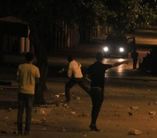
21 Palestinian citizens suffered bullet injuries at dawn Friday during clashes with invading Israeli troops east of Nablus city.
Local sources said that the clashes broke out when more than 1,500 Jewish settlers under military protection stormed after midnight the mausoleum of Joseph's Tomb near Balata refugee camp to the east of Nablus
They added that the soldiers showered the angry young men with tear gas and stun grenades, and intensively used live and rubber bullets.
The bullet injuries the young men sustained were described as slight to moderate, according to medical sources at Rafidia hospital in Nablus.
Local sources said that the clashes broke out when more than 1,500 Jewish settlers under military protection stormed after midnight the mausoleum of Joseph's Tomb near Balata refugee camp to the east of Nablus
They added that the soldiers showered the angry young men with tear gas and stun grenades, and intensively used live and rubber bullets.
The bullet injuries the young men sustained were described as slight to moderate, according to medical sources at Rafidia hospital in Nablus.
14 may 2015
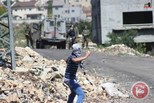
Israeli forces injured three Palestinian children with live fire during severe clashes that erupted between soldiers and school students in the Jabal al-Tawil neighborhood of al-Bireh in the occupied West Bank Thursday, witnesses said.
The injured children were taken to a hospital for treatment, while Israeli forces detained six Palestinian children, all under 10 years of age, and took them to the nearby Psagot settlement, locals told Ma'an.
Israeli forces had reportedly set up an ambush for the students prior to the clashes, locals added.
An Israeli army spokeswoman did not have immediate information but told Ma'an she was looking into the incident.
Palestinian children routinely come under live fire and excessive force from Israeli forces, according to children's rights group Defense for Children International- Palestine.
Israeli forces shot and injured at least 30 children across the occupied West Bank and East Jerusalem since the beginning of this year as of March 24, 2015, DCIP reported.
While Israeli military regulation permits the use of live ammunition when a direct mortal threat exists, the DCIP found no evidence that any of the children injured in 2015 thus far posed such a threat to Israeli forces or settlers.
Israeli military courts rarely prosecute members of Israeli forces in such cases, leading to what rights groups argue a culture of impunity that enables incidents like Thursday's injuries.
From 2000-2012, only 117 of 2,207 investigations opened by the Military Police Criminal Investigations Division were indicted, about 5 percent of the total files opened, according to Israeli human rights group Yesh Din.
Palestinian Ambassador to the UN Riyad Mansour sent an open letter to the UN Security Council earlier this month demanding that Israel be brought to justice over violations and abuse against Palestinian children.
The injured children were taken to a hospital for treatment, while Israeli forces detained six Palestinian children, all under 10 years of age, and took them to the nearby Psagot settlement, locals told Ma'an.
Israeli forces had reportedly set up an ambush for the students prior to the clashes, locals added.
An Israeli army spokeswoman did not have immediate information but told Ma'an she was looking into the incident.
Palestinian children routinely come under live fire and excessive force from Israeli forces, according to children's rights group Defense for Children International- Palestine.
Israeli forces shot and injured at least 30 children across the occupied West Bank and East Jerusalem since the beginning of this year as of March 24, 2015, DCIP reported.
While Israeli military regulation permits the use of live ammunition when a direct mortal threat exists, the DCIP found no evidence that any of the children injured in 2015 thus far posed such a threat to Israeli forces or settlers.
Israeli military courts rarely prosecute members of Israeli forces in such cases, leading to what rights groups argue a culture of impunity that enables incidents like Thursday's injuries.
From 2000-2012, only 117 of 2,207 investigations opened by the Military Police Criminal Investigations Division were indicted, about 5 percent of the total files opened, according to Israeli human rights group Yesh Din.
Palestinian Ambassador to the UN Riyad Mansour sent an open letter to the UN Security Council earlier this month demanding that Israel be brought to justice over violations and abuse against Palestinian children.
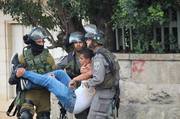
Israeli occupation forces Thursday noon, opened fire on youngsters staging Nakba anniversary demonstration near the 300 military checkpoint on the northern entrance of Bethlehem.
PNN reporter said that a boy was wounded in his leg during the clashes, where the soldiers carried and arrested him.
Reporter added that Israeli forces detained a number of boys during the demonstration.
PNN reporter said that a boy was wounded in his leg during the clashes, where the soldiers carried and arrested him.
Reporter added that Israeli forces detained a number of boys during the demonstration.
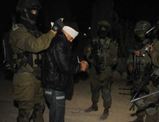
Israeli Soldiers kidnapped on Wednesday evening a Palestinian child in Hebron, and a man in the Old Askar refugee camp, in the northern West Bank city of Nablus, and invaded Huwwara town near Nablus before imposing curfew, forcing the residents under house arrest.
Media sources in the southern West Bank city of Hebron said the soldiers attacked, and beat, a 10-year-old child, in the Old City of Hebron, and kidnapped him.
The child has been identified as Farhan Nader Rajabi, 10; he suffered various cuts and bruises.
In addition, undercover forces of the Israeli army, driving a civilian car with Palestinian license plates, invaded the Old Askar refugee camp, in Nablus, and kidnapped one Palestinian, identified as Nasser Naqeeb.
Eyewitnesses said the resident was kidnapped in a store in the center of the camp, and was taken to an unknown destination.
On Wednesday at night, soldiers invaded Huwwara town, south of Nablus, and imposed curfew forcing the entire town under house arrest.
Eyewitnesses said that several military vehicles invaded the town, forced all stores shut, and fired a number of gas bombs and concussion grenades in addition to a number of flares, and imposed curfew.
Media sources in the southern West Bank city of Hebron said the soldiers attacked, and beat, a 10-year-old child, in the Old City of Hebron, and kidnapped him.
The child has been identified as Farhan Nader Rajabi, 10; he suffered various cuts and bruises.
In addition, undercover forces of the Israeli army, driving a civilian car with Palestinian license plates, invaded the Old Askar refugee camp, in Nablus, and kidnapped one Palestinian, identified as Nasser Naqeeb.
Eyewitnesses said the resident was kidnapped in a store in the center of the camp, and was taken to an unknown destination.
On Wednesday at night, soldiers invaded Huwwara town, south of Nablus, and imposed curfew forcing the entire town under house arrest.
Eyewitnesses said that several military vehicles invaded the town, forced all stores shut, and fired a number of gas bombs and concussion grenades in addition to a number of flares, and imposed curfew.
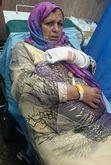
Israeli occupation cops on Wednesday broke the arm of a Palestinian elderly woman after having detained her for 24 hours on her way back home to Qalqiliya from Jordan.
A PIC correspondent quoted the woman’s son as stating: “Israeli policemen broke my mother’s arm after they aggressively shoved her into a patrol of their own.”
The casualty, identified as 60-year-old Yusra Mohamed Qatesh, headed to Jordan to renew her passport as part of routine procedures to arrange a Umrah (pilgrimage) trip, the son added.
He said the family was shocked as they caught sight of the Israeli intelligence officers cracking down on his mother at the Karama overpass and seizing her for over 12 hours. The Israeli cops dragged the lady to an investigation center in Jerusalem’s Ma’aleh Adumim settlement, where she has been kept in remand until six a.m. on Wednesday.
The elderly civilian was verbally and physically assaulted by an Israeli female soldier and two cops who forced her into an Israeli army jeep in an attempt to transfer her to al-Mascoubiya investigation center.
“You are a dirty Palestinian” and “We will throw you next to dirty Palestinian women!” were kinds of insults which the casualty firmly rebuffed, moments before the soldiers beat her up, paying no heed to her age or gender.
The mother was rushed to a local hospital in Occupied Jerusalem to be treated for the inflicted fractures. She was released shortly afterwards.
A PIC correspondent quoted the woman’s son as stating: “Israeli policemen broke my mother’s arm after they aggressively shoved her into a patrol of their own.”
The casualty, identified as 60-year-old Yusra Mohamed Qatesh, headed to Jordan to renew her passport as part of routine procedures to arrange a Umrah (pilgrimage) trip, the son added.
He said the family was shocked as they caught sight of the Israeli intelligence officers cracking down on his mother at the Karama overpass and seizing her for over 12 hours. The Israeli cops dragged the lady to an investigation center in Jerusalem’s Ma’aleh Adumim settlement, where she has been kept in remand until six a.m. on Wednesday.
The elderly civilian was verbally and physically assaulted by an Israeli female soldier and two cops who forced her into an Israeli army jeep in an attempt to transfer her to al-Mascoubiya investigation center.
“You are a dirty Palestinian” and “We will throw you next to dirty Palestinian women!” were kinds of insults which the casualty firmly rebuffed, moments before the soldiers beat her up, paying no heed to her age or gender.
The mother was rushed to a local hospital in Occupied Jerusalem to be treated for the inflicted fractures. She was released shortly afterwards.
13 may 2015
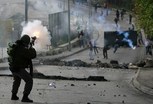
Violent confrontations were erupted Wednesday afternoon outside Ofer prison to the west of Ramallah during popular march to mark the 67th anniversary of Nakba (catastrophe).
Dozens of Palestinian youths marched towards Ofer prison in commemoration of Nakba anniversary. The clashes broke out when the protesters started stoning the Israeli soldiers and setting fire to tires in the vicinity of the prison.
In their turn, Israeli soldiers heavily fired tear gas bombs and rubber bullets towards the protesters. A number of them suffered breathing problems after inhaling tear gas canisters.
Dozens of Palestinian youths marched towards Ofer prison in commemoration of Nakba anniversary. The clashes broke out when the protesters started stoning the Israeli soldiers and setting fire to tires in the vicinity of the prison.
In their turn, Israeli soldiers heavily fired tear gas bombs and rubber bullets towards the protesters. A number of them suffered breathing problems after inhaling tear gas canisters.
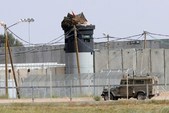
The Israeli occupation forces (IOF) on Tuesday evening opened machinegun fire at Palestinian farmers and homes in a southern area of the Gaza Strip.
Press sources said that Israeli border soldiers opened fire as usual at farmers and homes in Khan Younis, with no reported casualties.
Press sources said that Israeli border soldiers opened fire as usual at farmers and homes in Khan Younis, with no reported casualties.
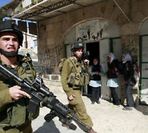
Israeli soldiers invaded, on Wednesday at dawn, several Palestinian communities in the northern West Bank city of Nablus, broke into and searched a number of homes leading to cashes with local youths.
Media sources in Nablus said clashes took place near Balata refugee camp, east of Nablus, after dozens of soldiers invade the area, in addition to the Amman Street and the Joseph Tomb area.
The soldiers fired dozens of gas bombs near the main entrance of Balata refugee camp, causing many Palestinians to suffer the effects of teargas inhalation.
The army also invaded Madama village, broke into the homes of Basel, Bajes and No’man Jadallah, and searched them before photographing the properties' interior and exterior.
The soldiers asked Jadallah to deliver a verbal “warning message” to the headmaster of the nearby local high school, informing him that the army will shoot any student who leaves school during schooldays.
They also said that the army would be repeatedly invading all homes along the settlers bypass road should local youths throw stones on settlers’ cars, and army vehicles.
In related news, several army vehicles invaded the site of the former Dothan military base, near ‘Arraba town, south of Jenin, and started bulldozing the site.
Media sources in Nablus said clashes took place near Balata refugee camp, east of Nablus, after dozens of soldiers invade the area, in addition to the Amman Street and the Joseph Tomb area.
The soldiers fired dozens of gas bombs near the main entrance of Balata refugee camp, causing many Palestinians to suffer the effects of teargas inhalation.
The army also invaded Madama village, broke into the homes of Basel, Bajes and No’man Jadallah, and searched them before photographing the properties' interior and exterior.
The soldiers asked Jadallah to deliver a verbal “warning message” to the headmaster of the nearby local high school, informing him that the army will shoot any student who leaves school during schooldays.
They also said that the army would be repeatedly invading all homes along the settlers bypass road should local youths throw stones on settlers’ cars, and army vehicles.
In related news, several army vehicles invaded the site of the former Dothan military base, near ‘Arraba town, south of Jenin, and started bulldozing the site.
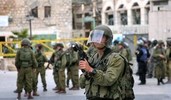
The Israeli Occupation Forces (IOF) stormed Tuesday evening a number of towns in Jenin, where they stopped and searched several Palestinian vehicles at makeshift checkpoints.
A military checkpoint was erected at the southern entrance to Jenin when IOF brutally stormed the city and roamed throughout a number of neighborhoods, local sources said.
Makeshift checkpoints were also erected at the entrances to Yabod, Qabatiya, Anza, and Arraba towns, the sources added.
A military checkpoint was erected at the southern entrance to Jenin when IOF brutally stormed the city and roamed throughout a number of neighborhoods, local sources said.
Makeshift checkpoints were also erected at the entrances to Yabod, Qabatiya, Anza, and Arraba towns, the sources added.
12 may 2015

Clashes erupted Monday evening between Palestinians and Israeli Occupation Forces (IOF) as the army stormed Aroub refugee camp in northern al-Khalil.
Local sources revealed that the IOF soldiers stormed the camp and were deployed on rooftops which led to the eruption of clashes.
Palestinian youths confronted the Israeli soldiers by throwing stones and empty bottles, while the soldiers fired stun grenades and tear gas, the sources added.
The IOF soldiers surveyed the surrounding mountains under the pretext of conducting military drills which are ongoing in the area, the sources said.
Local sources revealed that the IOF soldiers stormed the camp and were deployed on rooftops which led to the eruption of clashes.
Palestinian youths confronted the Israeli soldiers by throwing stones and empty bottles, while the soldiers fired stun grenades and tear gas, the sources added.
The IOF soldiers surveyed the surrounding mountains under the pretext of conducting military drills which are ongoing in the area, the sources said.
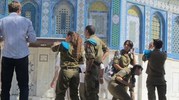
At least 53 Israeli soldiers stormed the plazas of Muslims’ Holy al-Aqsa Mosque via al-Maghareba Gate on Tuesday morning.
Local sources said 53 Israeli officers and 15 fanatic settlers, escorted by policemen, forced their way into the courtyards of the holy compound.
The male and female sit-inners and worshipers stood on their guard to the desecration break-in, yelling “Allah the Greatest” all the way through.
Meanwhile, the Israeli cops banned the Jerusalemite lady Ma’ali Seyam from entering Jerusalem’s Old City for 15 days after they summoned her for interrogation in the local Qishleh investigation center on Monday afternoon.
Local sources said 53 Israeli officers and 15 fanatic settlers, escorted by policemen, forced their way into the courtyards of the holy compound.
The male and female sit-inners and worshipers stood on their guard to the desecration break-in, yelling “Allah the Greatest” all the way through.
Meanwhile, the Israeli cops banned the Jerusalemite lady Ma’ali Seyam from entering Jerusalem’s Old City for 15 days after they summoned her for interrogation in the local Qishleh investigation center on Monday afternoon.

Israeli occupation forces have reportedly opened fire at Palestinian farms in the eastern part of the Gaza Strip, burning a large amount of wheat crops.
No casualties were reported, as the farmers fled the region two days ago, after a limited Israeli incursion. Along the previous two weeks, Palestinian farmers, whose farms lie near the eastern borders of the Gaza Strip, have been reporting Israeli occupation opening fire at them.
Medical sources also reported that several farmers were wounded during the same time.
Related: PCHR-Gaza: Israeli Buffer Zone Policies Typically Enforced with Live Fire
Farmers in the central area of the Strip told Days of Palestine that Israeli military activities in the area caused the burning of their wheat crops along the eastern borders.
“From Monday morning until Tuesday morning, we have been hearing Israeli occupation forces firing bullets and watching them firing light bombs above our farms near the borders,” Hani Ali said.
“At the same time, we heard sounds of sonic booms and saw fighter jets flying in the skies,” he further stated, adding, “I expect these activities were military drills.”
No casualties were reported, as the farmers fled the region two days ago, after a limited Israeli incursion. Along the previous two weeks, Palestinian farmers, whose farms lie near the eastern borders of the Gaza Strip, have been reporting Israeli occupation opening fire at them.
Medical sources also reported that several farmers were wounded during the same time.
Related: PCHR-Gaza: Israeli Buffer Zone Policies Typically Enforced with Live Fire
Farmers in the central area of the Strip told Days of Palestine that Israeli military activities in the area caused the burning of their wheat crops along the eastern borders.
“From Monday morning until Tuesday morning, we have been hearing Israeli occupation forces firing bullets and watching them firing light bombs above our farms near the borders,” Hani Ali said.
“At the same time, we heard sounds of sonic booms and saw fighter jets flying in the skies,” he further stated, adding, “I expect these activities were military drills.”
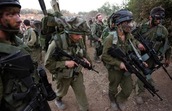
Israeli occupation forces Tuesday morning have conducted military drills in several areas in the Hebron district, southern West Bank.
The drill took place in Wadi Al joz and Farsh Al-Hawa neighborhoods in the city. Back in August, Israeli authorities evicted 1,300 Palestinians from their homes in the south Hebron hills, in the West Bank, claiming they reside in an army military training firing zone.
Israeli forces as well arrested a citizen from Beit Ommar village north Hebron, after raiding his home.
In march, Israeli forces launched military drill in the areas surrounding Gaza, without any previous warning. The drill contained active movement of military machines and warplanes, in addition to bombardment noises that last until late night hours.
In December, Israeli occupation forces held military live ammunition training in Khirbet Tawil area South Nablus, West Bank.
Military training has often targeted Palestinians, including children, causing several injuries and home evictions.
In October, Israeli Occupation Forces stormed into Aida refugee camp without any provocation and began shooting tear gas, sound bombs and rubber coated steel bullets at children in the streets.
Eyewitness back then said that soldiers were training by using families, children and homes as military practice.
In October as well, Israeli Occupation authorities distributed eviction threats to 19 Palestinian families in the area of the Northern Jordan valleys, in order to use area for military purposes.
The drill took place in Wadi Al joz and Farsh Al-Hawa neighborhoods in the city. Back in August, Israeli authorities evicted 1,300 Palestinians from their homes in the south Hebron hills, in the West Bank, claiming they reside in an army military training firing zone.
Israeli forces as well arrested a citizen from Beit Ommar village north Hebron, after raiding his home.
In march, Israeli forces launched military drill in the areas surrounding Gaza, without any previous warning. The drill contained active movement of military machines and warplanes, in addition to bombardment noises that last until late night hours.
In December, Israeli occupation forces held military live ammunition training in Khirbet Tawil area South Nablus, West Bank.
Military training has often targeted Palestinians, including children, causing several injuries and home evictions.
In October, Israeli Occupation Forces stormed into Aida refugee camp without any provocation and began shooting tear gas, sound bombs and rubber coated steel bullets at children in the streets.
Eyewitness back then said that soldiers were training by using families, children and homes as military practice.
In October as well, Israeli Occupation authorities distributed eviction threats to 19 Palestinian families in the area of the Northern Jordan valleys, in order to use area for military purposes.
